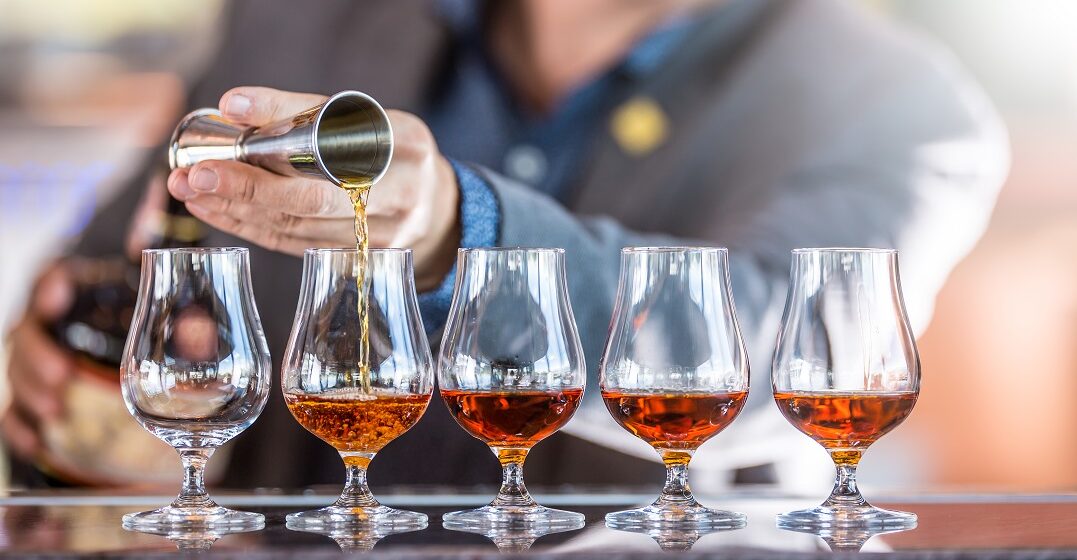Updated on January 3, 2024

What is a French digestif? 7 drinks you need to try

So what is un digestif, and how does it differ from un apéritif? Even if you’re only a beginner in French, you may have already guessed that the word digestif – referring to drinks you consume after a meal – is linked to la digestion. Indeed, according to tradition, digestive drinks are served after many French meals. On the other hand, apéritifs are served before a meal, often with a few nibbles, to whet your appetite.
French digestifs tend to be sweeter and have a higher alcohol content than apéritif drinks. But certain alcohols, like wines and whiskey, can be served both as a French digestif and apéritif. With that in mind, here is our selection of seven of the most famous digestive drinks in France.
Cognac is a brandy with an alcohol content of 40%. It has a richer and sweeter flavor than your average liqueur. Like Champagne and the wines of Bordeaux, Bourgogne or Beaujolais, it owes its name to the French region it comes from. After being distilled and aged in an oak cask for two years, it is blended with various cognacs from different years by le maître de chai (cellar master). It’s often served at room temperature in a tulip-shaped or balloon-shaped glass that allows it to interact with the air.
Like Cognac, Armagnac is an aged brandy containing 40% of alcohol. The oldest brandy in France, it’s made with grapes from the small region it takes its name from, at the foot of the Pyrénées mountains. Given its small production, it’s rarely sold outside of France. It’s usually poured into a balloon-shaped glass, ideally 15 to 30 minutes before being served so as to be at room temperature.
Yet another aged brandy, Calvados is made not of grapes, but apples that are pressed, fermented and double-distilled in order to become a cider. The remaining eau de vie must then be aged in a wood cask for a minimum period of two years. The older it gets, the smoother it becomes, and the higher its price tag is… It can be served dry or with ice, either as an apéritif or a digestif, or even at the end of the meal with a plate of cheese.
Well-known as an ingredient of margaritas and cosmopolitans, Cointreau can also be drunk on its own as a digestive or an apéritif. Contrary to other famous French liqueurs, it doesn’t owe its name to a French region, but to its inventors, the Cointreau brothers. The triple sec (dry) liqueur combines sweet and bitter orange peels with sugar beet alcohol, which gives it its orange flavor.
Grand Marnier is another brandy made in the region of Cognac. But it bears more resemblance to Cointreau, as it also mixes bitter oranges with sugar. This sweet fruity liquor can be used in various cocktails and desserts, such as the crêpes flambées (flamed pancakes). It can also be served as a digestif, traditionally with an orange slice dangling on the glass.
Once you know that crème de cassis means “blackcurrant cream” in French, you won’t be surprised to learn that this digestif is a sweet-flavored red blackcurrant liqueur. Made in the regions of Burgundy and Dijon, it can also be used to prepare un Kir royal, a famous French cocktail.
Maybe more than any other drink on our list, the Chartreuse French liqueur is surrounded by mystery. To this day, only two monks are said to know the secret recipe of 130 plants, flowers and herbs. The legend goes all the way back to 1605, when the duke of Estrées allegedly first handed the mysterious formula of un élixir de longue vie (an elixir for a long life) to the Chartreuse monks in Paris. However, it was only in 1764 that the monks of the Grande-Chartreuse monastery, near Grenoble, created an original digestive from the elixir.
The two types of Chartreuse we know today were both invented in 1840: la Chartreuse verte (the green Chartreuse) is the stronger one, with an alcohol content of 55%, while la Chartreuse jaune (the yellow Chartreuse) is milder and sweeter, with a more standard 40% of alcohol content. The colors that give them their names are due to the specific mix of plants and herbs that compose them.
There are other French digestifs we could have included. But the seven names in our list are undoubtedly the most famous and most common alcoholic drinks you’re likely to be served after a meal. Some of them can also appear before the meal, as an apéritif, or be used to make specific cocktails and desserts. Now, go out there, order a French meal and flaunt your newfound knowledge to the waiter!